On the 13th of December 2023 the Zambian Government through the Ministry of Agriculture unveiled its 2022 to 2026 Agriculture Strategic Plan. In the plan were a number of deliverables that included set targets to develop 20 Climate Smart Agriculture Technologies and Practices by 2026 against a baseline of 5 that were set in 2021. It has also set a target to ensure increased production of the countries staple food crop (Maize) from a baseline of 3.6million metric tons set in 2021 to 4million metric tons by 2026.
It’s important to appreciate that these goals cannot be attained in isolation but require an appreciation of the role played by other sector players in the agriculture ecosystem like agriculture insurance. The enhancement of Climate Smart Agriculture Technologies has improved the efficiency of agriculture risk management thereby giving insurance companies increased appetite to enter into agriculture insurance realms that they have never explored before. This has resulted in increase in the uptake of agriculture insurance which has been proven as a catalyst for increased crop production among farmers.
While we acknowledge the important role that agriculture insurance continues to play in the agriculture sector, it is imperative that we take note of the major strides that technology has brought to the sector resulting in transformative changes in the manner that agriculture insurance is administered. The insurance industry as a whole is benefitting from digital advances, ranging from Predictive Analytics to Internet of Things (IoT). Agriculture insurance is no exception, the sector is rapidly adopting these advancements, which not only make assessments quicker and more precise but also result in customized, cost-effective solutions for farmers.
To fully appreciate the revolution that technology has brought to agriculture insurance, we have to look at some of the challenges that are shrouded in traditional methods of implementing agriculture insurance. Traditional agriculture insurance heavily relies on historical data, seasonal patterns and manual inspections, factors or variables whose status quo is now challenged due to drastic changes in weather patterns in the last two decades.
Among the challenges around traditional agriculture insurance practices are Firstly, the time taken to carry out risk and loss assessments is usually a lengthy process as it often requires that insurers go on site to physically observe the risk parameters surrounding the farm or specific crop to be insured. This process delays both the onboarding of new insurance covers and settlement of claims to the detriment of both the insurer and the farmer. Secondly providing generic policies is one of the hall marks of traditional agriculture insurance, but unfortunately it does not carter to the specific needs of individual farmers which technology has come to address. Thirdly due to the high dependence on manual systems, there is an increased risk of errors which compromises the accuracy of pricing and claim settlement and fourthly due to factors like the high price structures associated with traditional insurance, it is more challenging to scale it up as most farmers find it expensive.
The aforementioned challenges in the implementation of traditional agriculture insurance, have been worsened by an additional layer of complexity in climate change which has made traditional agriculture insurance increasingly inadequate thereby necessitating a shift towards technological innovations.
In part 2 of this article, we will look at some of the technological innovations that have been adopted and the value they have brought to the agriculture insurance space.
Authored by: Dean Simuchimba (BSc. Agric, MSc. Agric Risk Mgt)
Agriculture Underwriter, Klapton Re
